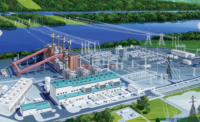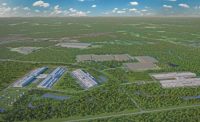The energy sector propelled construction activity in this year’s ENR MidAtlantic Top Starts list. The compilation, which ranks by total cost the largest regional projects on which substantial construction began in 2017, was boosted by seven energy-related projects. The largest project on the list—the $6-billion Shell ethylene cracker plant in Monaca, Pa.—is so large that the facility’s “early works project” was ranked No. 17 as a separate $200-million contract. A Trumbull Energy Services and Mascaro joint venture completed the early works, which included earthwork, road movement and a parking garage. Another team, led by general contractor Babcock & Wilcox, started the rest of the ethylene project in November.
The list’s seven energy projects are proof that the MidAtlantic is “one of the most active—if not the most active—regions in terms of power plant development and natural gas exploration and production in recent years,” says Kevin Needham, president of Kiewit Engineering Group Inc.
Kiewit has three power projects on the list, all in Pennsylvania. They are: No. 6-ranked Hickory Run energy station in North Beaver Township ($863 million); the No. 7 CPV Fairview Energy Center in Johnstown ($700 million); and No. 10 Birdsboro Power natural gas-fired power plant ($425 million). “We are also tracking and actively bidding a number of projects in the surrounding states,” Needham says.
Overall, this year’s list includes 25 projects with a combined value of $21.2 billion. That’s more than double the total value of last year’s roster, which included 50 projects, four of which were power plants. Projects on the new list—compiled using information from Dodge Data & Analytics, plus details provided by firms—all exceed $149 million. By comparison, the smallest contract on last year’s list was $106 million. The lists draw from projects located in Delaware, Maryland, Pennsylvania, Virginia, West Virginia and the District of Columbia.
ENR MidAtlantic 2017 Top Starts
The largest nonenergy contract on the latest list was Maryland’s Purple Line, in the District of Columbia suburbs. The 16-mile light rail project, estimated at $2 billion, was ranked No. 4. The other transportation infrastructure project on the list is the $396-million Scudder Falls Bridge replacement, which links Bucks County, Pa., and Mercer County, N.J. Hill International is serving as the project’s construction manager for the No. 11-ranked project. Michael Griffin, Hill’s regional president for the Americas, says the project replaces a “functionally obsolete” bridge that has “too narrow and dangerous entrance and exit ramps on both sides of the river.”
The Scudder Falls project failed to secure state and federal grants and was funded by the Delaware River Joint Toll Bridge Commission. Federal infrastructure projects have been mostly absent from the Top Starts list in the last three years. But the $21.2-billion federal infrastructure funds earmarked in the recently signed $1.3-trillion spending package could change that. Griffin says the legislation will boost “much-needed highway, transit and aviation needs” in the region and beyond. “The states, transit authorities and airports will now be able to plan their work programs for the next couple of years, knowing that this funding is in place,” he says. “Hopefully this puts a big dent in state-of-good-repair projects.”
Four hospital projects also made the list this year, including the $1.5-billion Penn Medicine Pavilion in West Philadelphia at No. 5. Two other Philadelphia higher-education projects were ranked as well. A private student housing project called The View–Phase II ($199 million) adjacent to Temple University’s campus was ranked No. 18, three slots ahead of the No. 21 Temple University Library ($170 million).
The Temple library is one of the marquee projects in the region for LERA Consulting Structural Engineers. Elias Matar, a LERA partner, says his firm is “optimistic about the near future” despite “rumors” that the market is due for a correction. “We are trying to bring in as much work as we can into the pipeline,” he says, “so we can at least remain busy as long as we can.”
Power generation projects could slow down in the coming years. Kiewit’s Needham says the sector shows signs of “overbuild.” But he also says that as the region’s numerous, aging coal-fired generation plants are retired, “We see continued opportunities for gas-fired generation to take over coal’s role as baseload.”










Post a comment to this article
Report Abusive Comment